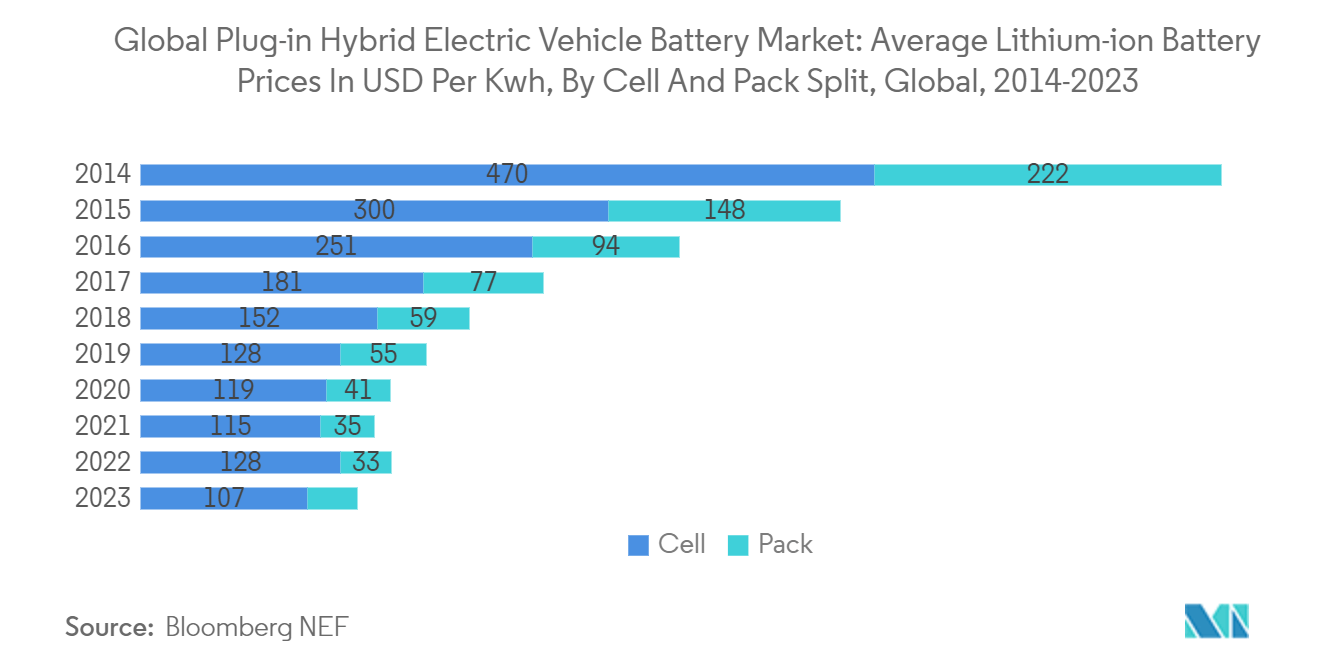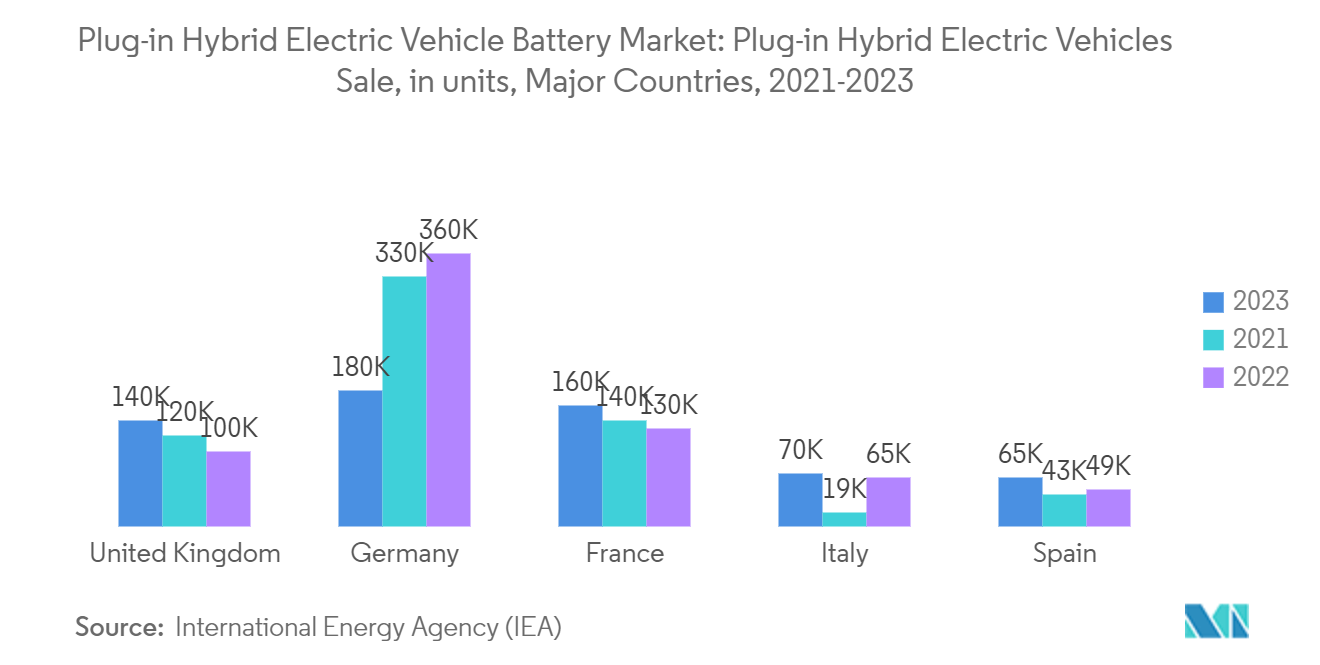Market Trends of Plug-in Hybrid Electric Vehicle Battery Industry
Lithium-Ion Battery Type Dominate the Market
- The lithium-ion electric vehicle battery market worldwide presents a fascinating landscape of opportunities and challenges. Due to their favorable capacity-to-weight ratio, lithium-ion rechargeable batteries are gaining more popularity than other battery technologies. Factors contributing to their increased adoption include enhanced performance (such as longer lifespan and lower maintenance requirements), extended shelf life, and decreasing prices. The price of lithium-ion batteries is usually higher than that of other batteries. However, major players across the market have been investing to gain economies of scale and R&D activities to enhance their performance, increasing the competition and, in turn, resulting in declining prices of lithium-ion batteries.
- Owing to the increasing average battery pack prices of electric vehicles (EV) and battery energy storage systems (BESS), the battery prices declined in 2023 to USD 139 /kWh, a decrease of over 13%. The trajectory of technological innovation and manufacturing enhancements is anticipated to decrease the battery pack prices further, projecting the price to reach USD 113/kWh in 2025 and USD 80/kWh in 2030.
- Furthermore, governments worldwide are significantly promoting electric vehicles due to rising environmental concerns. The government is significantly focused on net zero carbon emission targets. The demand for electric vehicles is significant across the globe, and companies are investing heavily to fulfill the rising demand for EVs.
- For instance, in March 2024, Hyundai announced it is likely to invest more than USD 50 billion in South Korea by 2026, with a considerable investment dedicated to boosting the development and production of electric vehicles across the country. The company aims to boost electric car production to more than 3.6 million units by 2030. Such initiatives are likely to raise the demand for late EVs across the country in the coming years and increase the demand for lithium-ion batteries during the forecast period.
- Additionally, the government worldwide has implemented various policies and incentives to promote electric vehicles. These policies have positively impacted the demand for lithium-ion batteries. The government announced numerous initiatives to promote EVs across the region.
- For instance, as of 2023, the Chinese government offers substantial subsidies for EV purchases, sometimes up to RMB 100,000 (USD 15,000) per vehicle. Additionally, EV buyers benefit from exemptions from the vehicle purchase tax, which can be a significant cost-saving opportunity for Chinese consumers. Such initiatives are likely to accelerate the production and demand of EVs across the country in the coming years and are likely to raise the demand for lithium-ion batteries in the forecast period.
- Such types of projects and investments are likely to increase EV production across the region, and there will be a rising demand for lithium-ion batteries during the forecast period.

Europe to Witness Significant Growth
- The Plug-in Hybrid Electric Vehicle (PHEV) battery market in Europe is expanding rapidly, driven by a combination of regulatory support, technological advancements, and increasing consumer demand for sustainable transportation solutions. The growth is fueled by government initiatives promoting battery production, the thriving EV industry, and the presence of numerous battery manufacturers in the region.
- The European region, including countries like Germany, the United Kingdom, and Sweden, is experiencing significant growth in the PHEV battery market. This is due to rising demand for eco-friendly vehicles and a robust governmental push toward reducing carbon emissions.
- The demand for plug-in hybrid electric vehicles (PHEV) is rising significantly across the region. Germany is the region's leading producer of PHEV. For instance, according to the International Energy Agency (IEA), in 2023, the sale of Plug-in Hybrid Electric Vehicles in Germany was 0.18 million units, followed by the United Kingdom and Japan with 0.14 million units. EV Sales are rising in the coming years as numerous EV production plants are set up across the European region, and the demand for plug-in hybrid electric vehicle (PHEV) batteries is increasing.
- Governments in the region are implementing various policies and incentives to promote the adoption of plug-in hybrid and electric vehicles. These include subsidies, tax benefits, and stringent emission norms which encourage manufacturers to produce more PHEVs.
- For instance, as of 2023, the government of Norway announced the adjustment of taxation for electric cars and plug-in hybrid cars used as company vehicles. Employers who provide employees with electric cars can deduct DKK 15,000 (USD 2,150) from the tax base from 2023 to 2026. This deduction applies to all zero-emission cars, supporting the uptake of EVs across the region. Such initiatives are likely to accelerate the production and demand of EVs across the country in the coming years and are likely to raise the demand for PHEV batteries during the forecast period.
- Moreover, the expansion of charging infrastructure across Europe makes PHEVs a more viable option for consumers. This infrastructure development, combined with advancements in battery technology and governmental support, positions the European market as a pivotal player in the global shift toward sustainable and electrified transportation. The government launched several initiatives to raise public charging points across the country in the coming years.
- For instance, in October 2023, the French government announced that it is likely to pour EUR 200 million (USD 216 million) into charging stations for electric cars. The government set a target of 400,000 public charging terminals by 2030. The 200 million euro package is intended to support the development of fast-charging stations and installations in public and commercial premises. Such initiatives and targets are likely to raise public charging points and surge the demand for PHEV batteries during the forecast period across the region.
- Such project developments showcase the feasibility and importance of PHEV battery solutions for battery energy storage systems in EVs and are likely to raise the demand for PHEV batteries across the country in the coming year.


